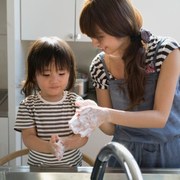 Photo: Getty Images
Photo: Getty Images
Impetigo, a contagious superficial skin infection, is typically caused by group A streptococcus, the same bacteria that results in strep throat. Methicillin-resistant staphylococcus aureus (MRSA) is also fast becoming a cause of this superficial skin infection, according to the PubHealth website. Impetigo, which usually affects preschoolers and school-age kids, causes blisters or sores on the hands, neck, face, and diaper area.
The infection develops when a child has repeatedly scratched an existing skin cut or rash and it becomes infected with the bacteria. In fact, a child is more likely to get impetigo if his or her skin is already aggravated by other issues like poison ivy, bug bites, eczema, or minor cuts and scrapes.
Since good hygiene can prevent this contagious superficial skin infection, parents can teach kids to wash hands frequently and keep fingernails neatly trimmed and clean.
According to the Mayo Clinic, impetigo can cause two different types of blisters, depending on the type of impetigo infection. Bullous impetigo produces large skin blisters and is almost always caused by S. aureus. In bullous impetigo cases, blisters form when S. aureus bacteria release a toxin which causes large, fluid-filled blisters. The fluid inside the blisters looks clear, and then turns cloudy.
Non-bullous impetigo, or crusted impetigo, is more common and can be caused by S. aureus or group A streptococcus. In non-bullous impetigo, small blisters appear, which later burst, leaving behind damp patches of red skin. Later, the affected area of skin will develop a brown crust.
Often your child’s physician can diagnose impetigo based on the skin rash, and will prescribe an antibiotic cream or oral medicine. If a culture is taken, PubMed reports that the streptococcus or staphylococcus bacteria usually grow, and the culture can also help determine if MRSA is causing the infection.
Since impetigo is contagious and often itchy, parents can help prevent the spread of the infection to other family members with a few common sense habits. Provide antibacterial soap at the sink, encourage frequent hand washing, and dry hands using separate hand towels or disposable paper towels. Bed linens and clothes should not be shared, either, until the household is free of impetigo.
Sources:
PubMed Health. Impetigo. Web. 28, Dec. 2011.
http://www.ncbi.nlm.nih.gov/pubmedhealth/PMH0001863
The Mayo Clinic. Impetigo. Web. 28, Dec. 2011.
http://www.mayoclinic.com/health/impetigo/DS00464/DSECTION=symptoms
Reviewed December 29, 2011
by Michele Blacksberg RN
Edited by Jody Smith



Add a Comment1 Comments
Using antibiotic creams in low concentration will kill good germs and help resistant staphylococcus to thrive. Please, please do not send your child to school if your child has this infection as it will infect others. If a child in the school is on steroid cream or immuno-supressed, they will become seriously ill.
December 30, 2011 - 11:59pmCheck out my website www.call111.com
This Comment